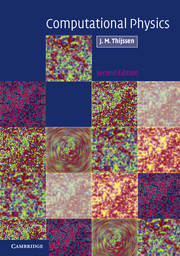Book contents
- Frontmatter
- Contents
- Preface to the first edition
- Preface to the second edition
- 1 Introduction
- 2 Quantum scattering with a spherically symmetric potential
- 3 The variational method for the Schrödinger equation
- 4 The Hartree–Fock method
- 5 Density functional theory
- 6 Solving the Schrödinger equation in periodic solids
- 7 Classical equilibrium statistical mechanics
- 8 Molecular dynamics simulations
- 9 Quantum molecular dynamics
- 10 The Monte Carlo method
- 11 Transfer matrix and diagonalisation of spin chains
- 12 Quantum Monte Carlo methods
- 13 The finite element method for partial differential equations
- 14 The lattice Boltzmann method for fluid dynamics
- 15 Computational methods for lattice field theories
- 16 High performance computing and parallelism
- Appendix A Numerical methods
- Appendix B Random number generators
- Index
11 - Transfer matrix and diagonalisation of spin chains
Published online by Cambridge University Press: 05 June 2012
- Frontmatter
- Contents
- Preface to the first edition
- Preface to the second edition
- 1 Introduction
- 2 Quantum scattering with a spherically symmetric potential
- 3 The variational method for the Schrödinger equation
- 4 The Hartree–Fock method
- 5 Density functional theory
- 6 Solving the Schrödinger equation in periodic solids
- 7 Classical equilibrium statistical mechanics
- 8 Molecular dynamics simulations
- 9 Quantum molecular dynamics
- 10 The Monte Carlo method
- 11 Transfer matrix and diagonalisation of spin chains
- 12 Quantum Monte Carlo methods
- 13 The finite element method for partial differential equations
- 14 The lattice Boltzmann method for fluid dynamics
- 15 Computational methods for lattice field theories
- 16 High performance computing and parallelism
- Appendix A Numerical methods
- Appendix B Random number generators
- Index
Summary
Introduction
In Chapters 8 and 10 we studied methods for simulating classical systems consisting of many interacting degrees of freedom. In these methods, a sequence of system configurations is generated, and from this sequence averages of physical quantities, given as functions of the degrees of freedom (positions and momenta, or spins), can be determined. These quantities are called mechanical quantities, and the expressions of their expectation values are called mechanical averages.
There exist, however, quantities that cannot be determined straightforwardly using these methods. These quantities include free energies and chemical potentials. The point is that these quantities are not given as a normalised average, which for mechanical quantities is replaced by an average over the configurations generated in the simulation. In the previous chapters we have seen that it is not straightforward to find free energies and chemical potentials using MC and MD methods (see Section 10.5).
In this chapter we discuss a method which enables us to find free energies for lattice spin models with very high accuracy; this is the transfer matrix method. This method calculates the free energy of a model defined on a strip of finite width and infinite length directly in terms of the largest eigenvalue of a large matrix, the transfer matrix. This matrix contains essentially the Boltzmann weights for adding an extra row of spins to the strip. In Chapter 12 we shall see that the transfer matrix is the analogue of the time evolution operator in quantum mechanics.
Information
- Type
- Chapter
- Information
- Computational Physics , pp. 338 - 371Publisher: Cambridge University PressPrint publication year: 2007
